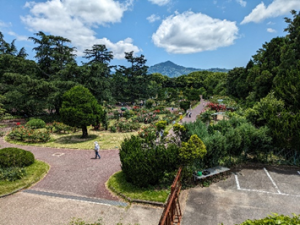京都の引力20 京で誕生した言葉と風景
土居好江

江戸時代後期を代表する浮世絵師・葛飾北斎。『冨嶽三十六景』、『北斎漫画』など富士山を描いた絵師ですが、90年の人生で93回の引っ越しを繰り返したことで有名です。75歳の時には引っ越し回数はすでに56回に達していたそうです。
江戸時代の引っ越しは行政の手続きも簡単だったと思われますが、これは異常な数です。家の掃除が出来なかったのが原因らしいのですが・・・・。
京都にも引っ越し魔の文人が住んでいました。江戸時代、頼山陽が鴨川から東を見て山紫水明と言う言葉をつくりましたが、まさに、この山が紫に染まるというのは、夕焼けのできる時刻のことを指しています。現在では京都の枕詞として使われていますが、頼山陽は手紙に「山紫水明の頃におこしください」という手紙を書いたのがはじまりです。
頼山陽が、43歳の時、文政5年(1822年)、京都へ来て六度目の家となる水西荘へ転居しました。水西荘は鴨川のほとり、丸太町大橋の北側、東三本木通にあった。文政11年(1828年)に水西荘を増築し、離れの「山紫水明処」が建てられたのです。
白樺派の代表的な作家・志賀直哉は、引越し魔で転居の回数は全部で23回。その住んだ場所も、尾道・松江・我孫子・京都・奈良・鎌倉など、暮らしやすく文化的な香りする古都が多く、作家活動に大いなる影響を与えたと思われます。京都の山科から奈良に転居したのは1925年(大正14年)42歳の時でした。
谷崎潤一郎は79年間で43回の引っ越しを繰り返しました。小説の舞台にも描かれた名邸 「潺湲亭(せんかんてい 現・石村亭)」(京都市左京区)は下鴨神社・糺の森の隣に位置し、築 100 年を超える閑静な邸宅で、2000 平方メートルもの敷地には、池を中心に御殿風の母屋や書斎、茶室などが配置されたお屋敷です。陰翳礼讃という言葉も、上京区の町家で暗がりの美意識の代名詞・陰翳礼讃と言い、山紫水明という熟語も京都に住んだ体験から生まれた味わいのある熟語ではないでしょうか。
「春はあけぼの」で始まる『枕草子』で清少納言は、「春は明け方がいい」と述べています。更に「夏は夜」「秋は夕暮れ」「冬は早朝」と季節のおススメの時刻を述べています。この原稿を書いていると、次から次へと京都で生まれた風景が頭を巡ります。京都は365日、24時間、絵になりますね。
以上
